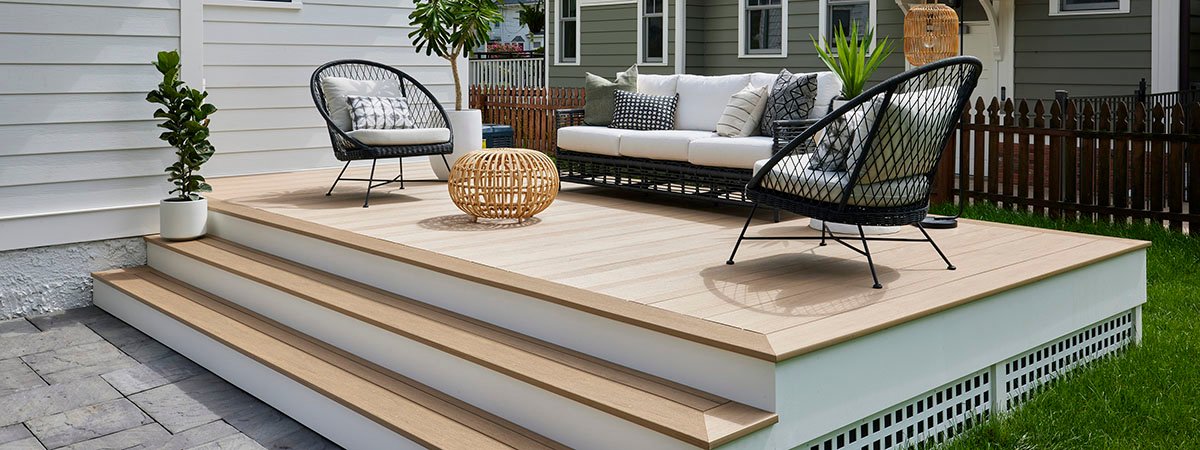Introduction
Designing a deck is more than choosing a pretty wood or a trendy railing it’s about creating an outdoor room that balances purpose, safety, materials, and long-term value. A well-designed deck extends living space, improves property appeal, and becomes a focal point for family life and entertaining. This guide condenses professional best practices into clear, actionable steps so you can plan a deck that fits your lifestyle, climate, and budget. I’ll walk through the essential planning choices, material pros and cons, layout and safety considerations, aesthetic integration with the landscape, and practical maintenance tips. Throughout, the focus is on approaches that align with building codes, user comfort, and durability so your deck performs beautifully over time. Whether you’re remodeling an existing deck or building new, these recommendations will help you avoid common mistakes and choose options that give the biggest payoff in enjoyment and resale value.
Planning and purpose
Start with honest answers: how will you use the deck dining, lounging, grilling, play, or mixed use? The primary functions determine size, shape, and load requirements. Consider sun and shade patterns across seasons, proximity to the house, access points (sliding doors, stairs), and how the deck will connect to paths, garden beds, or pools. Sketch multiple layout options and think about circulation allow at least 36–48 inches for through-traffic and more for dining and seating areas. Site considerations like slope, drainage, and tree proximity will affect foundation type and footings. Also confirm local zoning and building-code setbacks, permitted heights, and permit requirements before finalizing the footprint. A compact, well-zoned deck often outperforms a larger, poorly thought-out one. Plan zones (dining, cooking, lounge) with transitions steps, level changes, or rail details to manage flow and create purposeful outdoor rooms that match how you actually live outside.
Materials and durability
Material choice determines longevity, maintenance, cost, and look. Traditional pressure-treated wood offers a warm, natural aesthetic and lower upfront cost but requires regular sealing, staining, and inspection for rot. Cedar and redwood have natural rot resistance and attractive grain, though they are pricier and still need periodic care. Engineered composite decking minimizes maintenance, resists staining and insect damage, and often includes long warranties; modern composites vary in texture and color stability, so choose proven brands and investigate slip-resistance ratings. PVC decking is low-maintenance and highly weather-resistant but can cost more and expand with temperature. For railings and accents, consider powder-coated aluminum for low maintenance, glass panels for unobstructed views, or steel for industrial looks (ensure proper corrosion protection). Always match fasteners to decking material (stainless or coated screws for composites) and follow manufacturer recommendations for spacing and ventilation to prevent moisture buildup. Choosing the right material upfront reduces surprises and long-term costs.
Layout, safety, and structural best practices
A deck must be both beautiful and structurally sound. Footing depth and size should match frost lines in your region and be sized for load-bearing columns; decking joist spans, spacing, and ledger attachment to the house must follow local code and manufacturer spans. Use joist hangers, flashing at ledger boards, and through-bolts where required to avoid water intrusion and ledger failure. Railings must meet height and baluster spacing rules for safety, and guardrails are essential above certain heights. Consider lighting for steps and perimeter edges to prevent nighttime trips, and design stair widths for comfortable ascent. Accessibility matters: incorporate gentle step heights and consider ramps or landing-level transitions if the deck will serve family members with mobility needs. Finally, plan drainage and ventilation under the deck to prevent standing water and rot; proper airflow preserves framing and reduces pest issues. When in doubt, consult a structural engineer or a licensed contractor for unique or elevated designs.
Style, lighting, and landscape integration
A deck should feel like a natural extension of the home and the garden. Choose a palette and materials that complement exterior finishes: warm-toned woods pair with cottage-style homes, while cool composites and metal rails suit contemporary architecture. Use level changes, planters, and balustrade details to create visual separation between zones without blocking the view. Outdoor lighting transforms usability combine task lighting for cooking and steps with softer ambient sources for seating areas. Low-voltage LED fixtures, post-cap lights, and integrated stair lighting add function and mood while minimizing power use. Integrate planting by adding built-in planters or positioning potted greenery to create privacy and soften edges; for small yards, vertical screens or trellises with climbers add enclosure. Finally, think seasonally: choose sun and wind exposure-resistant furniture and fabrics, and plan shade (pergolas, awnings, umbrellas) to extend comfortable use through summer.
Maintenance strategies and long-term budgeting
Design with the future in mind: calculate both upfront build cost and long-term maintenance when choosing materials and finishes. Budget for periodic sealing, staining, or surface cleaning if you choose wood; composites reduce annual maintenance but may require specific cleaning products. Create an inspection routine: check fasteners, railings, flashing, and under-deck framing annually, and clear leaves and debris that trap moisture. Protect high-traffic zones with rugs rated for outdoor use and replace worn boards promptly to prevent further damage. Allocate 1–3% of the deck’s replacement value annually for maintenance and small repairs to avoid large, unexpected expenses. If your deck adjoins the house, schedule periodic checks of the ledger and flashing and refresh caulking as needed. A modest yearly investment in routine care keeps a deck safe and visually appealing and dramatically extends its lifespan.
Conclusion
Great deck design balances form, function, structural integrity, and maintenance practicality. Start with clear goals for how you will use the space, match materials to your climate and willingness to maintain, and design circulation and safety into every decision. Thoughtful integration with lighting and landscaping transforms a deck from a platform into a versatile outdoor room that adds both lifestyle value and curb appeal. By planning for longevity and using code-aware construction practices, you’ll build a deck that delivers years of enjoyment with manageable upkeep. Whether you DIY a simple platform or hire a contractor for a multi-level design, these principles will help you prioritize choices that matter most.
FAQs
Q1: What is the most durable low-maintenance decking material?
A: High-quality capped composite decking is generally the most low-maintenance and durable option for many climates, though proper installation matters.
Q2: Do I always need a permit to build a deck?
A: Permit requirements vary by location and depend on height, size, and whether the deck is attached; check local building department rules before starting.
Q3: How much space do I need for a dining area on a deck?
A: Allow at least 10–12 square feet per person for a comfortable dining zone; a 6-foot table typically needs a surrounding clearance of 3–4 feet for movement.
Q4: How often should I inspect my deck?
A: Inspect railings, stairs, flashing, and structural members annually, and after severe storms.
Q5: Can I build a deck next to my house without flashing?
A: No proper flashing at the ledger board is essential to prevent water infiltration and damage to the house framing.









